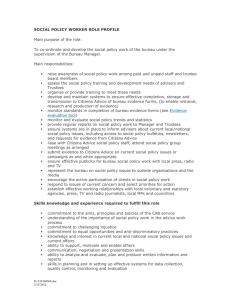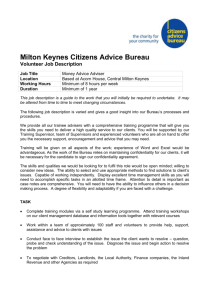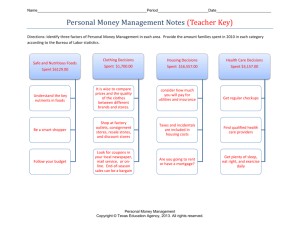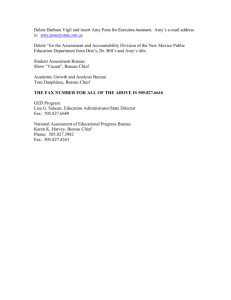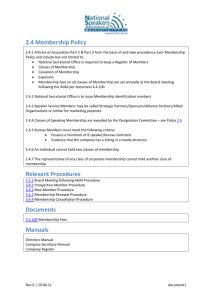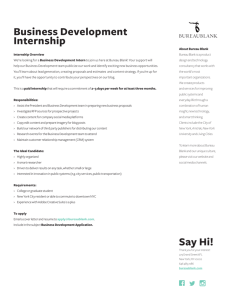PowerPoint - Population Reference Bureau
advertisement
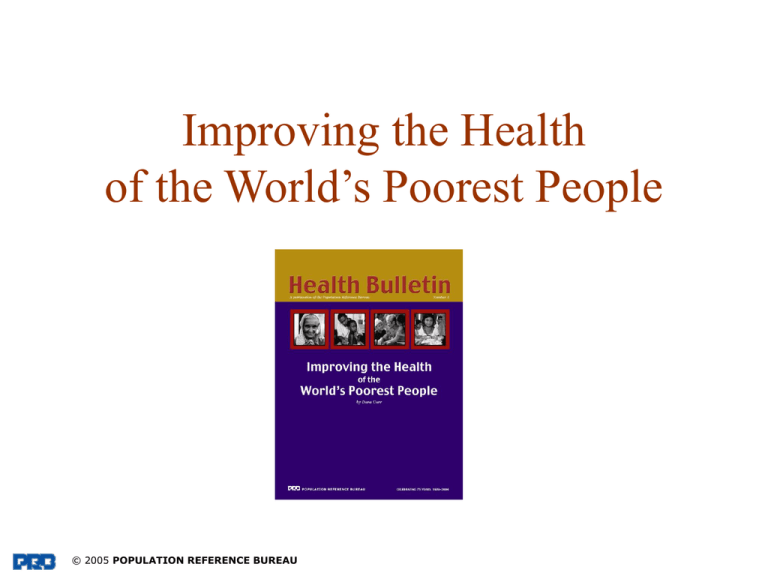
Improving the Health of the World’s Poorest People © 2005 POPULATION REFERENCE BUREAU Health and the World’s Poorest People • More than 1 billion people live on less than US$1 per day • Health services and modern medicines are out of reach • Millions of people die from preventable, curable diseases • Poverty is both a cause and an outcome of disease © 2005 POPULATION REFERENCE BUREAU Health for All by the Year 2000? • WHO led a global Health for All effort in the 1970s • Representatives from 130 governments signed a declaration in 1978, agreeing that: • “Inequality in the health status of people, particularly between developed and developing countries as well as within countries, is politically, socially, and economically unacceptable.” • Despite this effort, disparities persist © 2005 POPULATION REFERENCE BUREAU Poor-Rich Health Divide • • • • Between Poor and Rich Countries Within Countries Explaining Health Disparities Approaches for Improving the Health of the Poor © 2005 POPULATION REFERENCE BUREAU Health Divide Between Poor and Rich Countries Life Expectancy at Birth, 1995-2000 Years 64.6 74.8 65.4 48.7 World More Developed Regions Least Developed Countries Other Less Developed Countries Notes: More developed regions, according to the UN Population Division, include Australia, New Zealand, Europe, North America, and Japan. Less developed regions include Africa, Asia (excluding Japan), and Latin America and the Caribbean; 49 countries within these regions are classified as least developed. Source: United Nations (UN) Population Division, World Population Prospects: The 2002 Revision—Highlights, accessed online at www.un.org/esa/population/publications/wpp2002/WPP2002-HIGHLIGHTSrev1.PDF on June 17, 2003. © 2005 POPULATION REFERENCE BUREAU Health Divide Between Poor and Rich Countries • Poor countries assume heavier burden of disease • Developing countries disproportionately affected by many preventable and treatable diseases: HIV/AIDS, malaria, TB, malnutrition, maternal conditions, and childhood diseases (according to WHO) © 2005 POPULATION REFERENCE BUREAU Health Spending Per Capita, by Country Income Level, 1997 $1,907 $11 $23 Least developed countries Other lowincome countries $93 $241 LowerUpper-middle- High-income middle-income income countries countries countries Notes: As of 1998, other low-income countries are classified as having a per capita GNP less than US$760. Lower-middle-income countries are classified as having a per capita GNP between US$761 and US$3030. Upper-middle-income countries are classified as having a per capita GNP between US$3031 and US$9360. High-income countries are classified as having a per capita GNP greater than US$9360. Source: WHO, Macroeconomics and Health: Investing in Health for Economic Development (2001): 56. © 2005 POPULATION REFERENCE BUREAU Poor-Rich Health Divide Within Countries • Health disparities are also immense within countries • Inequalities in health risk; care-seeking behavior, diagnosis, and treatment; and incidence of disease, disability, and death • Poor fare worse than others on various health outcomes, including childhood mortality and nutritional status © 2005 POPULATION REFERENCE BUREAU Under-5 Mortality Rate (deaths per 1000 live births, by age 5) Poorest Quintile Richest Quintile 192 164 140 92 155 109 72 Zambia 2001-2002 Bangladesh 19992000 64 Haiti 2000 Cambodia 2000 Source: D. Gwatkin et al., Initial Country-Level Information About Socioeconomic Differences in Health, Nutrition, and Population, Volumes I and II (November 2003). © 2005 POPULATION REFERENCE BUREAU Women Receiving Delivery Assistance Poorest Quintile Richest Quintile Percent 98 94 77 45 31 20 20 4 Uganda 2000-2001 Nepal 2001 Egypt 2000 Peru 2000 Source: D. Gwatkin et al., Initial Country-Level Information About Socioeconomic Differences in Health, Nutrition, and Population, Volumes I and II (November 2003). © 2005 POPULATION REFERENCE BUREAU Explaining Health Disparities • Household: financial resources, education, health services, and nutrition • Community: drinking water, housing, transportation, family size, and age at marriage • Health system: access, quality, and availability • Government: policies and public spending © 2005 POPULATION REFERENCE BUREAU Share of Public Health Spending Received by Poor and Rich Poorest Quintile Richest Quintile 42 Percent 30 29 29 24 17 16 9 12 11 Jamaica 1989 Malaysia 1989 Egypt 1995 Vietnam 1992 Brazil 1985 Source: W.Hsiao and Y. Liu, “Health Care Financing: Assessing Its Relationship to Health Equity,” in Challenging Inequalities in Health: From Ethics to Action, ed. T Evans et al. (2001): 271. © 2005 POPULATION REFERENCE BUREAU What can be done? Approaches for Benefiting the Poor • • • • Socioeconomic approaches Health-service approaches Health-financing approaches Approaches for measuring progress © 2005 POPULATION REFERENCE BUREAU Socioeconomic Approaches • Policies that are pro-growth and pro-poor – Association of economic growth with inequality – Promotion of strong social policies for poor along with pro-growth policies • Investments in education – Safer jobs, higher health literacy, and preventive health care measures – Avoid risky behaviors, demand quality services © 2005 POPULATION REFERENCE BUREAU Health-Service Approaches • Directing more health benefits toward the poor through “targeting” • Promoting primary and essential health care – Investing in primary care – Improving the quality of services © 2005 POPULATION REFERENCE BUREAU Health-Service Approaches (Cont.) • Developing public-private partnerships to improve reach and responsiveness • Mobilizing community resources – Reorganizing health resources – Training community-based health workers – Involving traditional healers © 2005 POPULATION REFERENCE BUREAU Health-Financing Approaches • Inequity in financing: poor are disadvantaged; pay out-of-pocket; face large, unanticipated costs; and lack cash reserves • Strategies for greater financial protection: risk-sharing or insurance plans, subsidized or free hospital care, and community financed health plans © 2005 POPULATION REFERENCE BUREAU Approaches for Measuring Progress • Defining goals is challenging • Economic growth is associated with greater inequalities • Need to differentiate between absolute and relative success • Look beyond national averages to address disparities © 2005 POPULATION REFERENCE BUREAU Conclusion • Over 1 billion people do not have access to basic health care • Growing inequalities are leaving the poor at a disadvantage • Need for comprehensive pro-poor approaches • Public health interventions must focus on the poor (not necessarily the majority) © 2005 POPULATION REFERENCE BUREAU For More Information Dara Carr, “Improving the Health of the World’s Poorest People,” Health Bulletin 1 (Washington, DC: Population Reference Bureau, 2004). Available online at www.prb.org © 2005 POPULATION REFERENCE BUREAU
